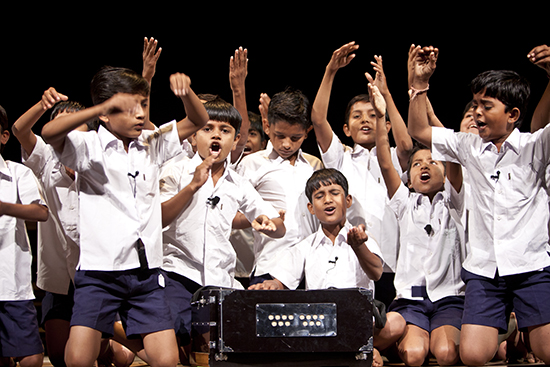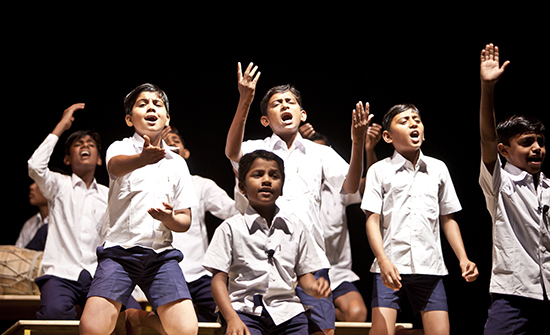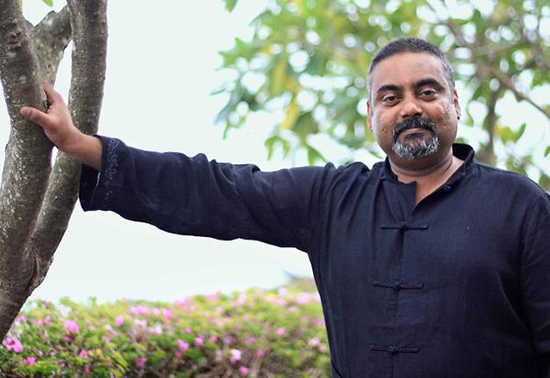WOMADelaide 2017: Saving the musical mind
Ben Brooker: interview, Roysten Abel, Manganiyar Classroom

Manganiyar Classroom
photo courtesy WOMADelaide 2017
Manganiyar Classroom
The Manganiyar are a Langha, or Muslim community, whose roots can be traced back to the medieval Rajput dynasties of the Indian subcontinent. They are folk musicians and oral storytellers, their ancestral home the vast Thar Desert that, stretching over 320,000 square kilometres, forms a natural border between India and Pakistan. Manganiyar culture combines secular and religious traditions, their songs constituting an oral history of the Thar region—recalling the exploits of Alexander the Great and the maharajas who ruled over the former native states—while also offering up praise to Krishna and the Sufi saints.
The name itself means something like ‘beggar’, a derogatory appellation derived from the close relationship the Manganiyar have traditionally cultivated with their wealthy Rajput patrons. It is now proudly claimed, and no wonder—the Manganiyar are virtuoso musicians whose unique vocal style and instrumentation have made them a major cultural export since their initial exposure to Western audiences in the 1960s and 70s.
The Indian director Roysten Abel first incorporated the music of the Manganiyar in Manganiyar Seduction, which saw an intergenerational group of 43 Manganiyar placed within a ‘magic box’ set—individual curtained compartments opening one by one to dramatically reveal the all-male musicians—inspired by the appearance of Amsterdam’s notorious red-light district. Premiering in 2006 in Delhi (the city that had, in 1963, played host to the first staged performance of Manganiyar music), the work also featured in the 2010 and 2011 Sydney and Perth festivals, and was well received by Australian audiences. In Manganiyar Classroom, which premiered in 2014 at Jackfruit, a children’s festival in Bangalore, Abel revisited the Manganiyar tradition, this time focusing on its youngest inheritors, school-age children from the villages of Rajasthan, the Northern Indian state bordering Pakistan.
Speaking to Abel by telephone, he tells me, “When I first encountered the Manganiyar people about 11 years ago I listened to a lot of musicians. At one point they brought their children along and I heard them sing for the first time. It was a mystical experience—they all had this high range and an extraordinary clarity of tone. It was from another world altogether. At that time I thought about creating a work with just the children, something along the lines of a boys’ choir. And then we went ahead with the other show [Manganiyar Seduction]. It was only a couple of years back when Gayathri Krishna, who runs an organisation called Bhoomija [a Bangalore-based performing arts trust], asked me if I would do my boys’ choir idea for the Jackfruit festival. The time seemed right, so I went back to Pakistan and asked what had happened to those children who had sung for me eight or so years before. Obviously they had grown up but what I had not expected was that they had lost the spark in their eyes. They had become timid, had dropped out of school. Then I kind of realised how much damage the public schooling system in their villages had done to them. And I thought maybe I won’t do a boys’ choir, maybe I’ll just start talking about the prevalent school system and how these kids might address that through their music. And that’s how Manganiyar Classroom came about.”

Manganiyar Classroom
photo courtesy WOMADelaide 2017
Manganiyar Classroom
In the work, Abel’s anxieties around the incompatibility of state education in Rajasthan with the Manganiyar tradition play out in the relationships between the 35-strong cast of eight to 16-year-old boys and two of their teachers: one old-fashioned and authoritarian, the other cleaving to the archetype of the inspirational educator who encourages his students to nurture their own creative and intellectual potential. Most of the children had not been on stage before—indeed, had never so much as seen a play—but their own experiences informed the work’s development and Abel’s final script.
More than anything, however, the work is a showcase for the boys’ unique variation of Manganiyar singing, a tradition passed down matrilineally by the women of Rajasthan who, Abel tells me, generally do not sing outside of their villages. The children perform most of the music themselves, providing their own accompaniment on a range of traditional Manganiyar instruments, including the percussive khartal and the harmonica-like morchang or so-called Jew’s harp. Abel explains to me, “This is music that’s been polished over centuries. There is a pain and joy in it that is universal. People come to me in tears after the show and they always say, ‘I’ve been moved.’ There is something deep within our audiences that it connects to.”
“Ultimately,” Abel tells me, “I see the production as a means to creating an alternative school for the Manganiyar children,” although he admits he is “not an educationalist.” His aim, he says, is to assemble a team on the back of Manganiyar Classroom capable of creating a school that is responsive to the specific needs and abilities of the children. “The homogenisation of education is a huge problem in India and Pakistan, and especially when it comes to communities like the Manganiyars, who are not like the children I’ve worked with in urban cities like Delhi. They are intelligent and efficient because of the music that they have in them. I miss those things when they are not there, which is a part of how I figured out how much potential these [Manganiyar] kids have.”

Roysten Abel
Roysten Abel, Manganiyar Classroom: PIAF, Perth, 3-4 March; Asia TOPA, Melbourne, 6-7 March; WOMADelaide, 10-13 March
RealTime issue #137 Feb-March 2017






